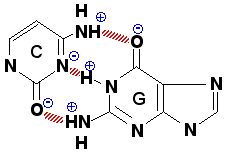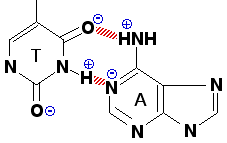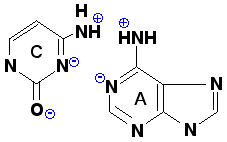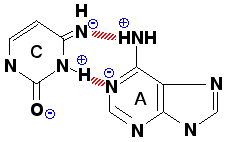

| MadSci Network: Biochemistry |
Hi Wamiq,
You're in luck; we already have an answer in our archives that addresses your question. You can read that answer (1004743083.Bc) by following this link.
That answer is pretty thorough, but I drew some pictures to help explain as well. Figures 1 and 2 show you the sort of base pairs that we expect to see in DNA molecules. Because the structure of DNA was first determined by James Watson and Francis Crick, we call these Watson-Crick base pairs. However, if you follow the links in the answer I mentioned above, you will see that there are many other ways for base pairs to form, it is just that these are not usually seen in double stranded DNA molecules.

|

|
| Figure 1. GC base pair | Figure 2. AT base pair |
Watson-Crick base pairs all have the same approximate geometry; this is why double-stranded DNA molecules have the same general shape, regardless of the sequence of each strand. The base pairs are held together with hydrogen bonds (shown in red) between slightly charged moities on each base. Slightly positively charged moities (>NH and -NH2 groups) are marked with a blue circled - sign, and slightly negatively charged moities (=O and =N- groups) are marked with a blue circled + sign. You can see how these slight positive and negative charges form a hydrogen bond, as the exposed protons in the -NH2 and >NH groups are attracted to the electrons in the =O and =N- groups.
An A:C base interaction is shown in Figure 3. You can see that the pattern of the slight positive and slight negative charges on the A and C bases prevent the formation of Watson Crick base pairs.

|

|
| Figure 3. A:C base interaction | Figure 4. A:tautomeric-C base interaction |
However, a small fraction of the time we can get a structure like that shown in Figure 4. Here, the electrons and one of the protons in the C base have moved between moities, so that we have a tautomer of the C base that can form hydrogen bonds with the A base. These tautomers are very short lived, but they occur frequently enough that you can sometimes have an A base incorporated into a new DNA strand opposite a C tautomer (for example). This is one of the sources of mutations that can occur in the DNA.
Keep asking questions!
Try the links in the MadSci Library for more information on Biochemistry.